Friday, May 12, 2006:
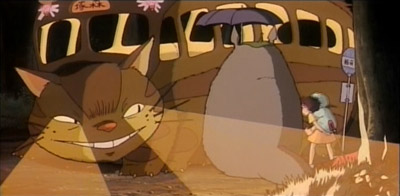
Stray Cats -- Rock This Town
The Stray Cats formed in New York in the late 1970s and had some success spearheading a rockabilly revival during the New Wave period, though their early album Built for Speed sold the best and their popularity tapered off afterwards. Their guitarist was Brian Setzer, whom you'll probably remember from the swing revival some time back; the man loves his roots music. I haven't heard most of his solo music, and I bought this LP on a lark (actually not true--I've never done anything on a lark, though I used to dine on a turkey), wondering if it could possibly be any good. And I think that it is.
[Stray Cats -- Built for Speed, or a more reasonably priced Greatest Hits comp]
...
In spite of having had plenty of time to prepare for an announced Miyazaki blogathon, my attentions were mostly elsewhere between then and now. So I'll just talk briefly about one of my favorite Miyazaki films, My Neighbor Totoro. It's a story about two girls (Mei and Satsuki) moving to a house near the forest; their father works at a university and their mother is in the hospital being treated for an unidentified illness. Like most of Miyazaki's work, it's got a fairly simple plot but takes some unexpected and wonderful turns: for instance, there are these odd black sooty creatures living in the house, which their father identifies as mak-kuro kurosuke, the spots you see when going from darkness to bright light, and which their elderly neighbor identifies as susu-atari, the creatures that live in old, empty houses and make dust.
On Satsuki's first day at school, Mei discovers an odd ghostly creature moving through the grass. She chases it through a low passage in the trees, almost a tunnel made of interleaved branches, then tumbles through a hole and meets Totoro, the king of the forest. I won't give the whole story away, but I wanted to post the following screenshots to give some idea of what it is I like about Miyazaki. I'm sure they'll explain it much better than I can--this sequence would be magic even if it weren't about a girl lending her father's umbrella to the keeper of the forest.

He has claws, yes. He takes the umbrella carefully, and Satsuki shows him how to use it.
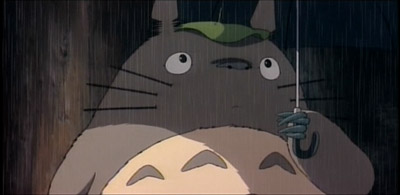
He decides he likes the sound the rain makes on the umbrella:
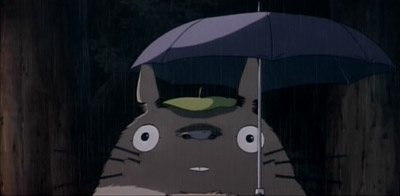


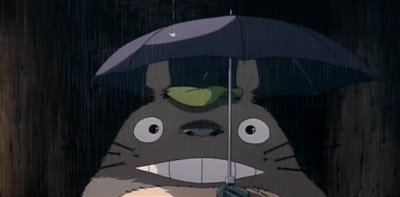
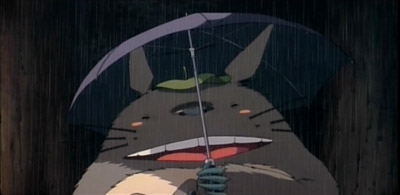
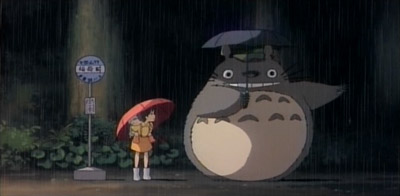

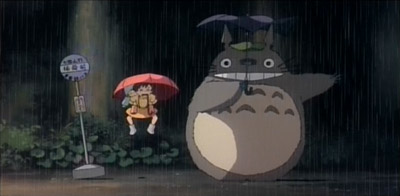

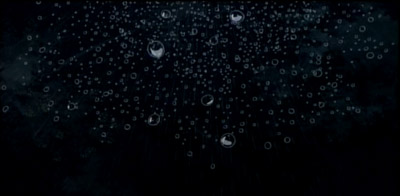
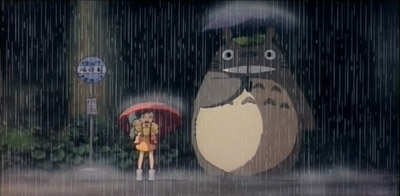
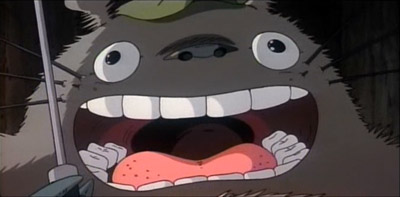
Aside from its quirkiness and its frequent mixture of menace and wide-eyed wonder, Miyazaki's work also shows a loving attention to detail. For instance, in My Neighbor Totoro there are the mice lights on the cat bus (the running lights at top), the dragonflies landing on garden posts, the discarded bottle at the bottom of a stream, the snail crawling up a plant's stalk, and the irises and lilies scattered in the landscape even in brief shots where the attention is directed elsewhere.
It's fun and fascinating work--even his earliest work in television has been worthwhile--and I'm happy that his films are widely available and in their original formats.
[Site dedicated to Hayao Miyazaki's work]
[Interview with Hayao Miyazaki: "It's not me who makes the film. The film makes itself and I have no choice but to follow."]
[Roger Ebert's writeup on Miyazaki and My Neighbor Totoro]
update: Quiet Bubble has writeups for Miyazaki's most recent three films, Princess Mononoke, Spirited Away, and Howl's Moving Castle. The first two are perceptive, but I can't speak to the third--I haven't yet seen the movie so I didn't read it. ^_^
Also see: Noel Vera on Howl's Moving Castle, cinemarati on On Your Mark, and CultureSpace on Spirited Away.
New at Quiet Bubble: writeups on Porco Rosso, Kiki's Delivery Service, Nausicaa, Lapute, and My Neighbor Totoro.
I'll be posting additional links to other posts in the Miyazaki-thon (Miyazaki-san-athon?) as I find them.
...
In other news, I'd like to recommend new mp3blog MadPriest-UK. First post: awesome soul mix. Second: Latin tracks. It's a good start.
Stray Cats and the cat bus

Stray Cats -- Rock This Town
The Stray Cats formed in New York in the late 1970s and had some success spearheading a rockabilly revival during the New Wave period, though their early album Built for Speed sold the best and their popularity tapered off afterwards. Their guitarist was Brian Setzer, whom you'll probably remember from the swing revival some time back; the man loves his roots music. I haven't heard most of his solo music, and I bought this LP on a lark (actually not true--I've never done anything on a lark, though I used to dine on a turkey), wondering if it could possibly be any good. And I think that it is.
[Stray Cats -- Built for Speed, or a more reasonably priced Greatest Hits comp]
...
In spite of having had plenty of time to prepare for an announced Miyazaki blogathon, my attentions were mostly elsewhere between then and now. So I'll just talk briefly about one of my favorite Miyazaki films, My Neighbor Totoro. It's a story about two girls (Mei and Satsuki) moving to a house near the forest; their father works at a university and their mother is in the hospital being treated for an unidentified illness. Like most of Miyazaki's work, it's got a fairly simple plot but takes some unexpected and wonderful turns: for instance, there are these odd black sooty creatures living in the house, which their father identifies as mak-kuro kurosuke, the spots you see when going from darkness to bright light, and which their elderly neighbor identifies as susu-atari, the creatures that live in old, empty houses and make dust.
On Satsuki's first day at school, Mei discovers an odd ghostly creature moving through the grass. She chases it through a low passage in the trees, almost a tunnel made of interleaved branches, then tumbles through a hole and meets Totoro, the king of the forest. I won't give the whole story away, but I wanted to post the following screenshots to give some idea of what it is I like about Miyazaki. I'm sure they'll explain it much better than I can--this sequence would be magic even if it weren't about a girl lending her father's umbrella to the keeper of the forest.

He has claws, yes. He takes the umbrella carefully, and Satsuki shows him how to use it.

He decides he likes the sound the rain makes on the umbrella:












Aside from its quirkiness and its frequent mixture of menace and wide-eyed wonder, Miyazaki's work also shows a loving attention to detail. For instance, in My Neighbor Totoro there are the mice lights on the cat bus (the running lights at top), the dragonflies landing on garden posts, the discarded bottle at the bottom of a stream, the snail crawling up a plant's stalk, and the irises and lilies scattered in the landscape even in brief shots where the attention is directed elsewhere.
It's fun and fascinating work--even his earliest work in television has been worthwhile--and I'm happy that his films are widely available and in their original formats.
[Site dedicated to Hayao Miyazaki's work]
[Interview with Hayao Miyazaki: "It's not me who makes the film. The film makes itself and I have no choice but to follow."]
[Roger Ebert's writeup on Miyazaki and My Neighbor Totoro]
update: Quiet Bubble has writeups for Miyazaki's most recent three films, Princess Mononoke, Spirited Away, and Howl's Moving Castle. The first two are perceptive, but I can't speak to the third--I haven't yet seen the movie so I didn't read it. ^_^
Also see: Noel Vera on Howl's Moving Castle, cinemarati on On Your Mark, and CultureSpace on Spirited Away.
New at Quiet Bubble: writeups on Porco Rosso, Kiki's Delivery Service, Nausicaa, Lapute, and My Neighbor Totoro.
I'll be posting additional links to other posts in the Miyazaki-thon (Miyazaki-san-athon?) as I find them.
...
In other news, I'd like to recommend new mp3blog MadPriest-UK. First post: awesome soul mix. Second: Latin tracks. It's a good start.
Comments:
<< Home
Cool post, Tuwa!
"which their father identifies as mak-kuro kurosuke, the spots you see when going from darkness to bright light, and which their elderly neighbor identifies as susu-atari, the creatures that live in old, empty houses and make dust."
Nice. I didn't realize this....
Great screen-caps idea.
(This was my favorite scene in the film.)
"which their father identifies as mak-kuro kurosuke, the spots you see when going from darkness to bright light, and which their elderly neighbor identifies as susu-atari, the creatures that live in old, empty houses and make dust."
Nice. I didn't realize this....
Great screen-caps idea.
(This was my favorite scene in the film.)
I'm glad you like it, Girish.
Some of the fansubbed Totoros give a lengthier explanation than the dialogue in the Disney version.
Speaking of, have you ever watched a film dubbed and subtitled at the same time? I did that with Crouching Tiger, Hidden Dragon when I first got a DVD player, and the two don't match up very well at all. Philosophically, it raises all kinds of questions of aboutness and authorship; pragmatically, it looks like it was just an attempt to have the English dialogue match the actors' mouth movements.
Some of the fansubbed Totoros give a lengthier explanation than the dialogue in the Disney version.
Speaking of, have you ever watched a film dubbed and subtitled at the same time? I did that with Crouching Tiger, Hidden Dragon when I first got a DVD player, and the two don't match up very well at all. Philosophically, it raises all kinds of questions of aboutness and authorship; pragmatically, it looks like it was just an attempt to have the English dialogue match the actors' mouth movements.
Tuwa, what a lovely post! Thank you! I appreciate that you offer insight into the mak-kuro kurosuke / susu-atari and call attention to Miyazaki's own "loving attention to detail." I remember being delighted by the mice lights on the cat bus!
"Speaking of, have you ever watched a film dubbed and subtitled at the same time?"
No, I haven't, not in the same language anyway.
It's interesting for me to see Indian (eg Satyajit Ray's) Bengali films and see how different (and often, prosaic--"just the facts") the subtitle translations are from the originals.
No, I haven't, not in the same language anyway.
It's interesting for me to see Indian (eg Satyajit Ray's) Bengali films and see how different (and often, prosaic--"just the facts") the subtitle translations are from the originals.
Thanks, Maya.
Girish, I've noticed the same thing with films in Spanish. I wonder if it's people tend to understand speech faster than they can read.
¶ Post a Comment
Girish, I've noticed the same thing with films in Spanish. I wonder if it's people tend to understand speech faster than they can read.
<< Home
